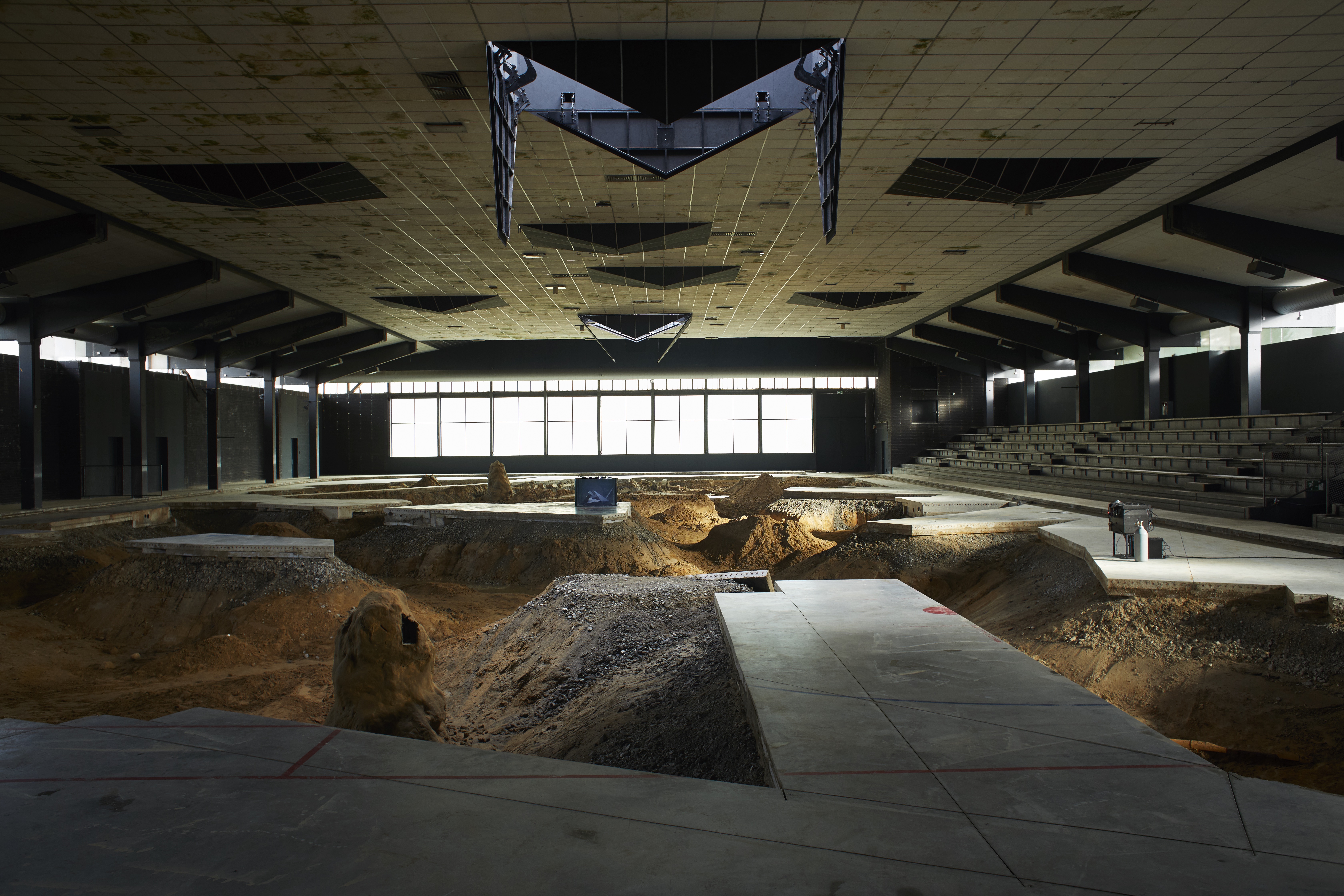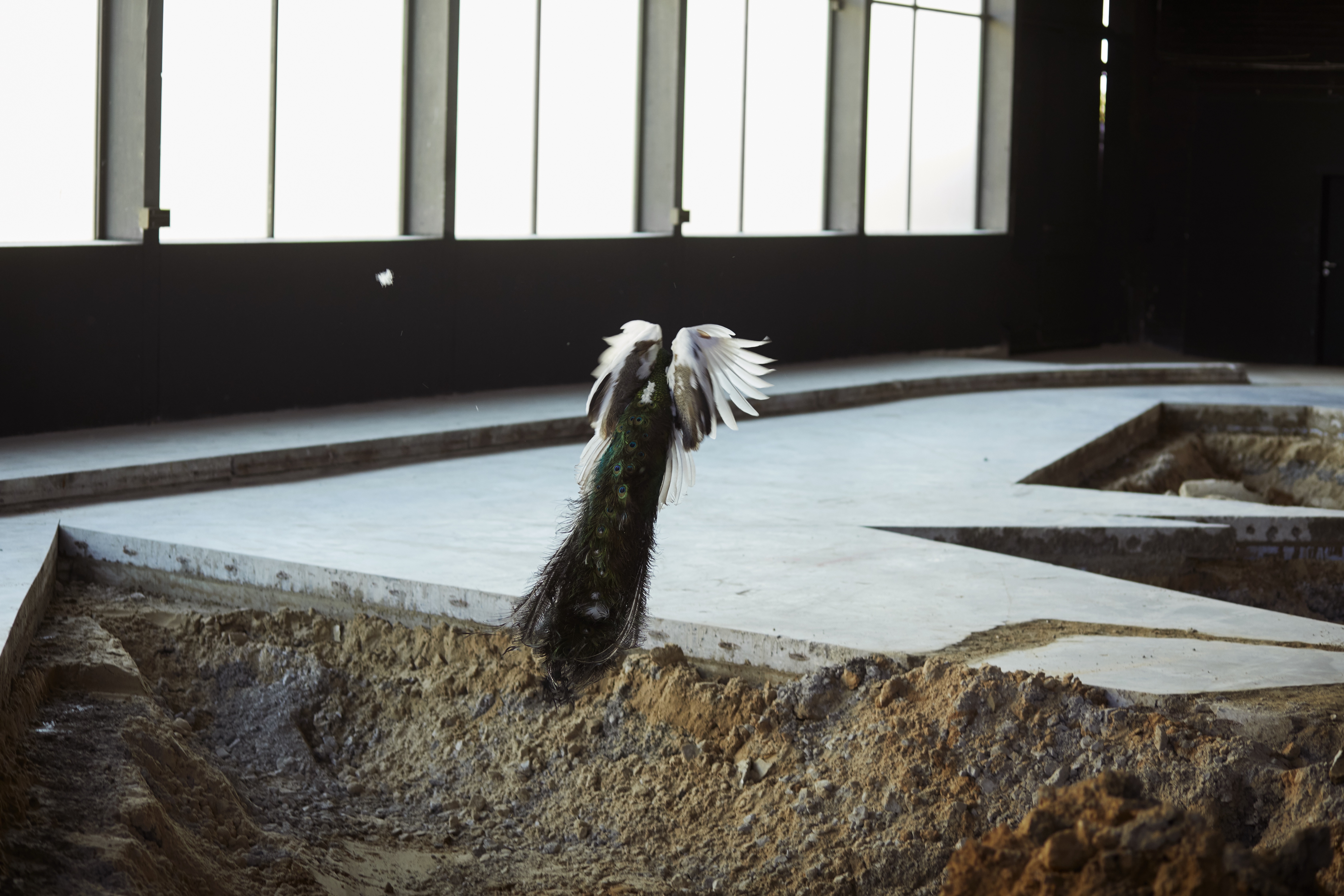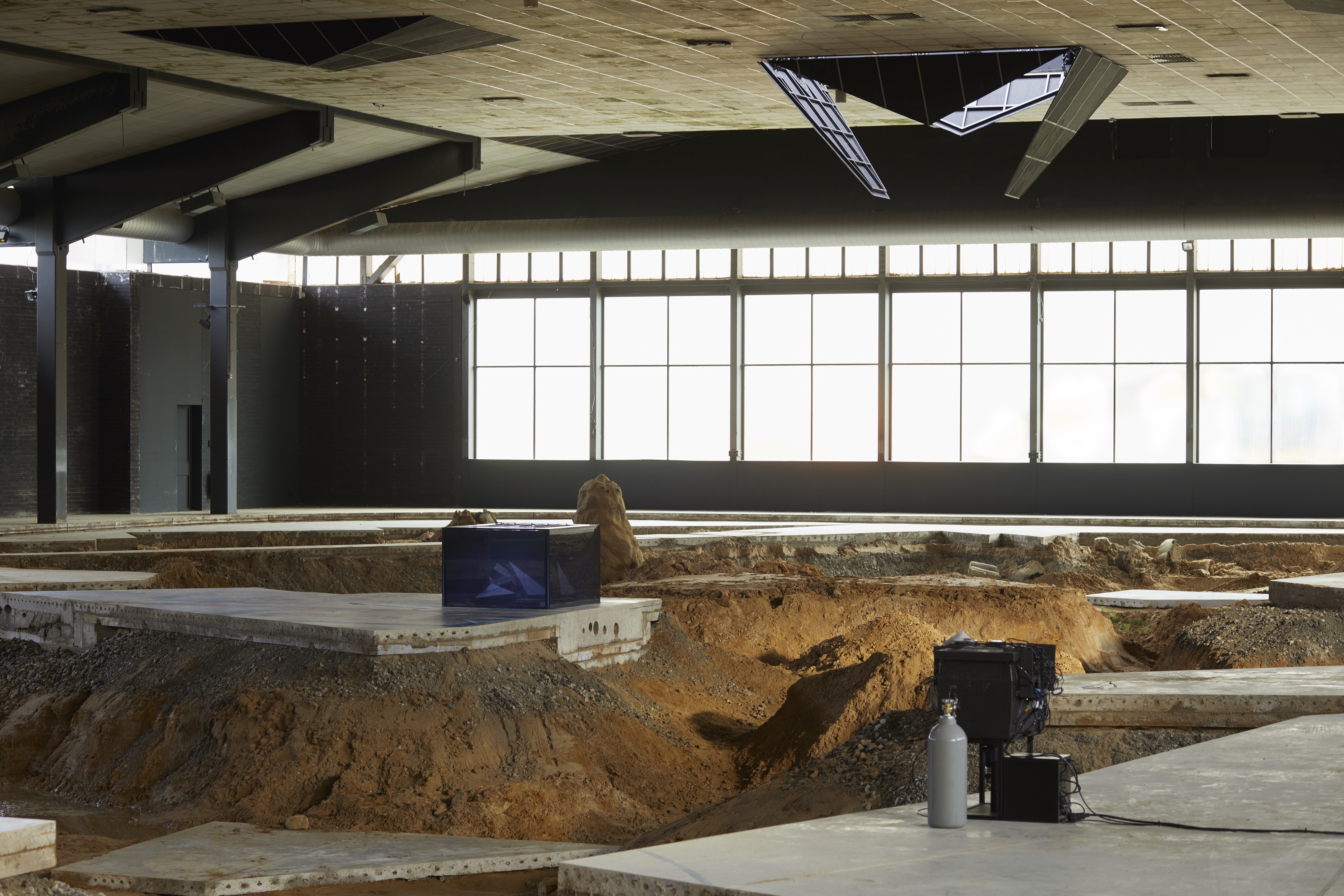
Walking into a disused ice rink on the outskirts of Münster Germany, I am unsure what to expect of Pierre Huyghe’s latest project, After ALife Ahead. The only available descriptions give hints but little substantive information. The artist’s statement reads, in part “Ice rink concrete floor. / Logic game. / Ammoniac. / Sand, clay, phreatic water. / Bacteria, algae, bee, chimera peacock.” But it’s unclear if that means these elements will be physically present or rather conceptually represented.
Entering his project at the decennial art event Skulptur Projekte Münster, however, I immediately see a broken concrete floor revealing sedimentary layers beneath; a ceiling with two sections periodically opening and closing, allowing natural elements into the ice rink’s artificial structure; and a glass aquarium resting atop an intact section of concrete. Another tank-like structure, which I soon learn is an incubator for cancer cells, rest on the edge of the rink. Two chimera peacocks hide in the rafters and tall mounds of dried dirt are active beehives. It becomes apparent that the artist’s statement is far from metaphorical; rather, it is extremely literal.
Shortly after my arrival, Huyghe emerges from a black door camouflaged into the wall of the building. Although he admits to worrying about the dust upsetting his allergies, we sit down on a bench in a corner, looking out at the dystopian ice rink—perhaps where skaters once sat to change their shoes. Despite After ALife Ahead’s overwhelming appearance, Huyghe s quick to say, “It is a place where an uncertain ecology might occur, [but] having a dramatic place wasn’t a goal. It is not about landscape.” What it is about—much like most of the artist’s oeuvre—is the living. Through his works, the fifty-four-year-old French artist often complicates natural life-cycles using artificial technology, but the same natural processes simultaneously interact with and overtake the artificiality.
For example, one aspect of After ALife Ahead is an algorithm that measures the average CO2 level, bacteria and movements of the bees and peacocks within the rink. The calculated vitality of the space then affects the speed at which the cancer cells replicate. In turn, the speed of the cells’ replication impacts the activity in a virtual-reality app that is available for all viewers to download for free on their smartphones. “An evolutionary algorithm [like the one used in the virtual reality app] could be considered an attempt to mimic life,” Huyghe says. He considered doing a project near a swamp in Münster, but ultimately decided that “in a certain way, I needed a roof, not just a biotic environment, but a speculative approach to a bio-tech environment and to see how heterogeneous systems could react in real time. It would’ve been technically impossible outdoors. Aside from this, it allowed After ALife Ahead to keep a vague relation with Untilled at Documenta 13 and at the same time push the self-organization further.”

Untilled, the environment he created in Kassel five years ago, included a beehive-headed sculpture, two greyhounds (one with a leg dyed pink), a man drawing his surroundings, and more. Reflecting further on the relationship between Untilled and After ALife Ahead, Huyghe says: “I’m not interested in a few connected elements, but rather in their interdependence, how they react and adapt to variables, and whether these interdependencies are discernible or not. For example, the augmented reality in After ALife Ahead can be experienced or not, and it is no more important than the ants that no one sees, but both happen to affect the whole situation for different reasons—or for no reason. So [it is about] experience but not always discernibility.”
Huyghe, who has shown around the world at institutions like the Centre Pompidou, Tate Modern and the Guggenheim in New York, continues to explain that in his work “it is a question of indiscernibility and unpredictability, something could arrive and you may or may not be [in the environment]. The point is not to confuse [the audience] for the sake of it, but to complexify where one thing is supposed to stop and where another begins. There are different self-generating patterns,” he says. “Each pattern has its own capacity and potential for change, its own unintentional variations. Because there are so many in proximity, they affect each other; they deregulate or re-regulate. They synchronize as well as engage in conflicts or dilemmas. This conditional setup is one way to shift from the centrality of the human position—whether as maker or receptor.”
Through the unpredictable, technological yet natural, and cyclical nature of After ALife Ahead, not only are viewers stripped of agency, but to an extent so is the artist. Once the environment was conceived, Huyghe relinquished control to his collaborators; he imagined the whole and then external specialists developed its parts. Once these parts were physically installed and implemented, Huyghe allowed the elements to change, shift and evolve together. Thus this project, along with many of his others, are technically never finished and often deemed installations—a delineation with which he does not agree.
“Usually, in art, what is not a fixed, compact object is either classified as performance or installation,” he says. “To install is to fix and performance is hysterical. Here, indiscernibility is to avoid, as much as possible, the categorization of things. By categorizing, things get fixed within an epistemic frame, installed within a category. Everything that does not go according to the frame or to the plan has to be removed. To make explicit this separation, this limit, I need porosity, leaks, accidents, contingency, dilemmas—whatever tools I can use. That’s why I collaborate with others. Collaborations are not social or an evolutionary need, but a tool to deregulate fixity of the self.”

When speaking about developing collaborations, Huyghe notes that finding open-minded collaborators is a difficult process. “The nature of what I do involves different realities. Once you go to see an expert, [the discussion] is often closed within a specialty of research. The specialist aligns perfectly within one field, but will be more or less blind to the other fields.”
“Kind of like a racehorse with blinders?” I ask.
“Yes, one could be the best horse but he still runs straight ahead, in a linear way. The difficulty is to find places where people have a certain porosity of thinking. That’s what takes time. It was particularly difficult for After ALife Ahead. Living Cancer Variator, a work I did at the Palais de Tokyo last year, was a test-run for this project [in Münster], a way to see how an external studio of specialists from different fields could work together. Each one is open-minded; they can talk to each other. Otherwise it’s impossible.”
Although his personal studio employs only four people, Huyghe now works with approximately twenty external collaborators, including specialists from MIT and programmers in New York. Much like the mindsets of these people, his projects’ technological developments must also maintain a level of porosity. “A set of operations based on conditional setups allow for a non-deterministic approach and variables to occur. They react [and] respond to external factors and modify themselves in real time, as learning could do,” he says. “It is not a fixed programme, animating compacted objects or controlling accidents.”
In order to expand these dialogues as well as the impact of his artworks, the next step for Huyghe is to create a garden, or a personal exhibition space—a place where limitations do not exist. “Museums, aside from their implicit subject/object exhibition construction, are under specific rules of address, access and expectations that reduce the encounter’s potential variables,” he says. “Here in Münster, in this place, things tend to be less controlled, but still some constraints remain—limitation of movement, security, temporality of the encounter. To overcome these limitations, I would lean toward a ‘garden approach’, meaning a place made by a particular—eventually irrational—mind, with indiscernible and unpredictable parts, and only then potentially share the space with people, but few and at their own risk, as it would not be under the rules of a public space,” he continues. For Huyghe, a garden, unlike a park or museum, would not be “planned and addressed for the public” and in this way, he says he would be able to execute his artworks and share them according to his precise, unrestrained vision.
This feature originally appeared in issue 33
BUY ISSUE 33





